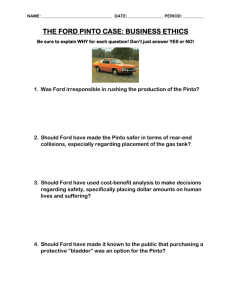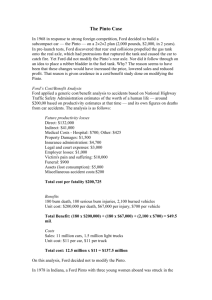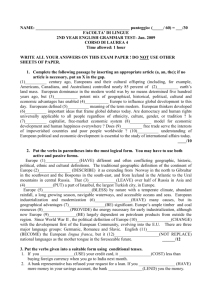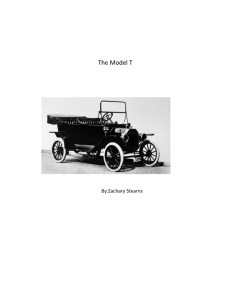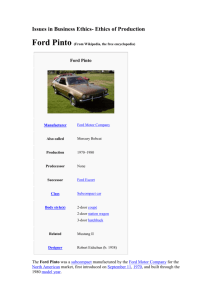Ford Pinto case - economics toolbox
advertisement
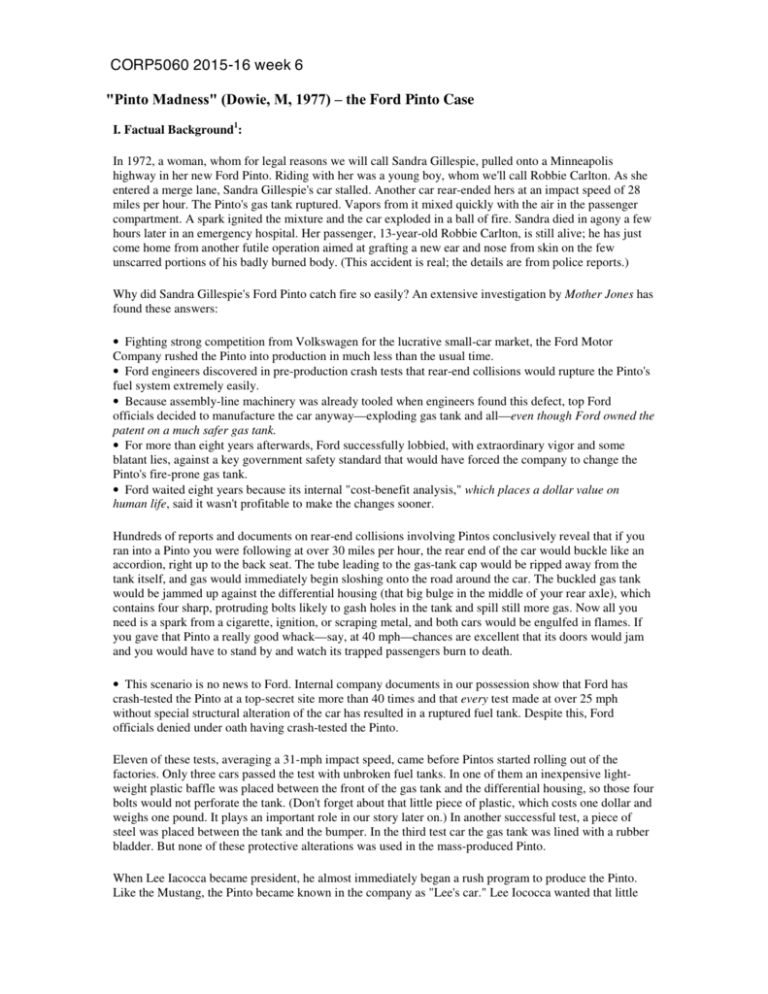
CORP5060 2015-16 week 6 3LQWR0DGQHVV'RZLH0±WKHFord Pinto Case I. Factual Background1: In 1972, a woman, whom for legal reasons we will call Sandra Gillespie, pulled onto a Minneapolis highway in her new Ford Pinto. Riding with her was a young boy, whom we'll call Robbie Carlton. As she entered a merge lane, Sandra Gillespie's car stalled. Another car rear-ended hers at an impact speed of 28 miles per hour. The Pinto's gas tank ruptured. Vapors from it mixed quickly with the air in the passenger compartment. A spark ignited the mixture and the car exploded in a ball of fire. Sandra died in agony a few hours later in an emergency hospital. Her passenger, 13-year-old Robbie Carlton, is still alive; he has just come home from another futile operation aimed at grafting a new ear and nose from skin on the few unscarred portions of his badly burned body. (This accident is real; the details are from police reports.) Why did Sandra Gillespie's Ford Pinto catch fire so easily? An extensive investigation by Mother Jones has found these answers: • Fighting strong competition from Volkswagen for the lucrative small-car market, the Ford Motor Company rushed the Pinto into production in much less than the usual time. • Ford engineers discovered in pre-production crash tests that rear-end collisions would rupture the Pinto's fuel system extremely easily. • Because assembly-line machinery was already tooled when engineers found this defect, top Ford officials decided to manufacture the car anyway—exploding gas tank and all—even though Ford owned the patent on a much safer gas tank. • For more than eight years afterwards, Ford successfully lobbied, with extraordinary vigor and some blatant lies, against a key government safety standard that would have forced the company to change the Pinto's fire-prone gas tank. • Ford waited eight years because its internal "cost-benefit analysis," which places a dollar value on human life, said it wasn't profitable to make the changes sooner. Hundreds of reports and documents on rear-end collisions involving Pintos conclusively reveal that if you ran into a Pinto you were following at over 30 miles per hour, the rear end of the car would buckle like an accordion, right up to the back seat. The tube leading to the gas-tank cap would be ripped away from the tank itself, and gas would immediately begin sloshing onto the road around the car. The buckled gas tank would be jammed up against the differential housing (that big bulge in the middle of your rear axle), which contains four sharp, protruding bolts likely to gash holes in the tank and spill still more gas. Now all you need is a spark from a cigarette, ignition, or scraping metal, and both cars would be engulfed in flames. If you gave that Pinto a really good whack—say, at 40 mph—chances are excellent that its doors would jam and you would have to stand by and watch its trapped passengers burn to death. • This scenario is no news to Ford. Internal company documents in our possession show that Ford has crash-tested the Pinto at a top-secret site more than 40 times and that every test made at over 25 mph without special structural alteration of the car has resulted in a ruptured fuel tank. Despite this, Ford officials denied under oath having crash-tested the Pinto. Eleven of these tests, averaging a 31-mph impact speed, came before Pintos started rolling out of the factories. Only three cars passed the test with unbroken fuel tanks. In one of them an inexpensive lightweight plastic baffle was placed between the front of the gas tank and the differential housing, so those four bolts would not perforate the tank. (Don't forget about that little piece of plastic, which costs one dollar and weighs one pound. It plays an important role in our story later on.) In another successful test, a piece of steel was placed between the tank and the bumper. In the third test car the gas tank was lined with a rubber bladder. But none of these protective alterations was used in the mass-produced Pinto. When Lee Iacocca became president, he almost immediately began a rush program to produce the Pinto. Like the Mustang, the Pinto became known in the company as "Lee's car." Lee Iococca wanted that little car in the showrooms of America with the 1971 models. So he ordered his engineering vice president, Bob Alexander, to oversee what was probably the shortest production planning period in modern automotive history. The normal time span from conception to production of a new car model is about 43 months. The Pinto schedule was set at just under 25. When it was discovered the gas tank was unsafe, did anyone go to Iacocca and tell him? "No," replied an engineer who worked on the Pinto, "That person would have been fired. Safety wasn't a popular subject around Ford in those days." Heightening the anti-safety pressure on Pinto engineers was an important goal set by Iacocca known as "the limits of 2,000." The Pinto was not to weigh an ounce over 2,000 pounds and not to cost a cent over $2,000. "Iacocca enforced these limits with an iron hand," recalls the engineer quoted earlier. So, even when a crash test showed that that one-pound, one-dollar piece of plastic stopped the puncture of the gas tank, it was thrown out as extra cost and extra weight. Stated in its simplest terms, cost-benefit analysis says that if the cost is greater than the benefit, the project is not worth it—no matter what the benefit. Ever wonder what your life is worth in dollars? Perhaps $10 million? Ford has a better idea: $200,000. From Ford Motor Company internal memorandum: "Fatalities Associated with Crash-Induced Fuel Leakage and Fires.": BENEFITS Savings: 180 burn deaths, 180 serious burn injuries, 2,100 burned vehicles. Unit Cost: $200,000 per death, $67,000 per injury, $700 per vehicle. Total Benefit: 180 X ($200,000) + 180 X ($67,000) + $2,100 X ($700) = $49.5 million. COSTS Sales: 11 million cars, 1.5 million light trucks. Unit Cost: $11 per car, $11 per truck. Total Cost: 11,000,000 X ($11) + 1,500,000 X ($11) = $137 million. First, note that Ford's table shows an equal number of burn deaths and burn injuries. All independent experts estimate that for each person who dies by an auto fire, many more are left with charred hands, faces and limbs. Andrew McGuire of the Northern California Burn Center estimates the ratio of burn injuries to deaths at ten to one instead of the one to one Ford shows here. Even though Ford values a burn at only a piddling $67,000 instead of the $200,000 price of a life, the true ratio obviously throws the company's calculations way off. The other side of the equation, the alleged $11 cost of a fire-prevention device, is also a misleading estimation. One document that was not sent to Washington by Ford was a "Confidential" cost analysis Mother Jones has managed to obtain, showing that crash fires could be largely prevented for considerably less than $11 a car. The cheapest method involves placing a heavy rubber bladder inside the gas tank to keep the fuel from spilling if the tank ruptures. Goodyear had developed the bladder and had demonstrated it to the automotive industry. On December 2, 1970 (two years before Echold sent his cost-benefit memo to Washington), Ford Motor Company ran a rear-end crash test on a car with the rubber bladder in the gas tank. The tank ruptured, but no fuel leaked. On January 15, 1971, Ford again tested the bladder and again it worked. The total purchase and installation cost of the bladder would have been $5.08 per car. That $5.08 could have saved the lives of Sandra Gillespie and several hundred others. The cost of retooling Pinto 2 assembly lines and of equipping each car with a safety gadget like that $5.08 Goodyear bladder was, company accountants calculated, greater than that of paying out millions to survivors like Robbie Carlton or to widows and widowers of victims like Sandra Gillespie. Remember that one-dollar, one-pound plastic baffle that was on one of the three modified Pintos that passed the pre-production crash tests nearly ten years ago? Well, it is a standard feature on the 1977 Pinto. In the Phoenix test it protected the gas tank from being perforated by those four bolts on the differential housing. II. Some legal background2: Most of the lawsuits against Ford were civil suits for actual and punitive damages, but one case involved criminal charges. In Indiana a rear-end collision between a van and a Pinto caused a fire which killed three teenage girls in the Pinto. Ford was subsequently tried in Indiana for the criminal charge of negligent homicide. There were no accompanying civil suits for this particular incident because, at the time, Indiana law severely limited the amount of damages which a parent could recover for the death of a minor child (no punitive damages were allowed and actual damages were limited to the lost wages which the minor might have earned in the time between his/her death and age 18). Many argue that Ford was acquitted of the negligent homicide charge because the standard of proof in a criminal charge is much higher than the standard of proof in a civil charge (reasonable doubt vs. a preponderance, or balancing, of the evidence). The most damaging civil case against Ford was Grimshaw vs. Ford, a California case in which a jury awarded $150 million in punitive damages (later reduced to $6 million on appeal). III. Discussion QuestionsIURP0DMRU)RXQGDWLRQ&RDOLWLRQ: 1) Is it ethical for a company, such as Ford, to perform cost-benefit analyses when lives are involved? ) Do you think that the public was adequately informed concerning the dangers of the Pinto? ) Ford designed the Pinto to satisfy all legal requirements for safety. Do they have a higher obligation? Does it matter that, during the design, Ford was successfully lobbying the US government to not impose more stringent safety requirements? Should a profession impose ethical obligations which are more stringent than legal obligations? If so, why? If so, how should they be enforced? 1 Excerpt from “Pinto Madness,” by Mark Dowie, Mother Jones Magazine, September/October 1977; http://www.motherjones.com/news/feature/1977/09/dowie.html 2 Adapted from a case by the Foundation Coalition, http://www.foundationcoalition.org 3
